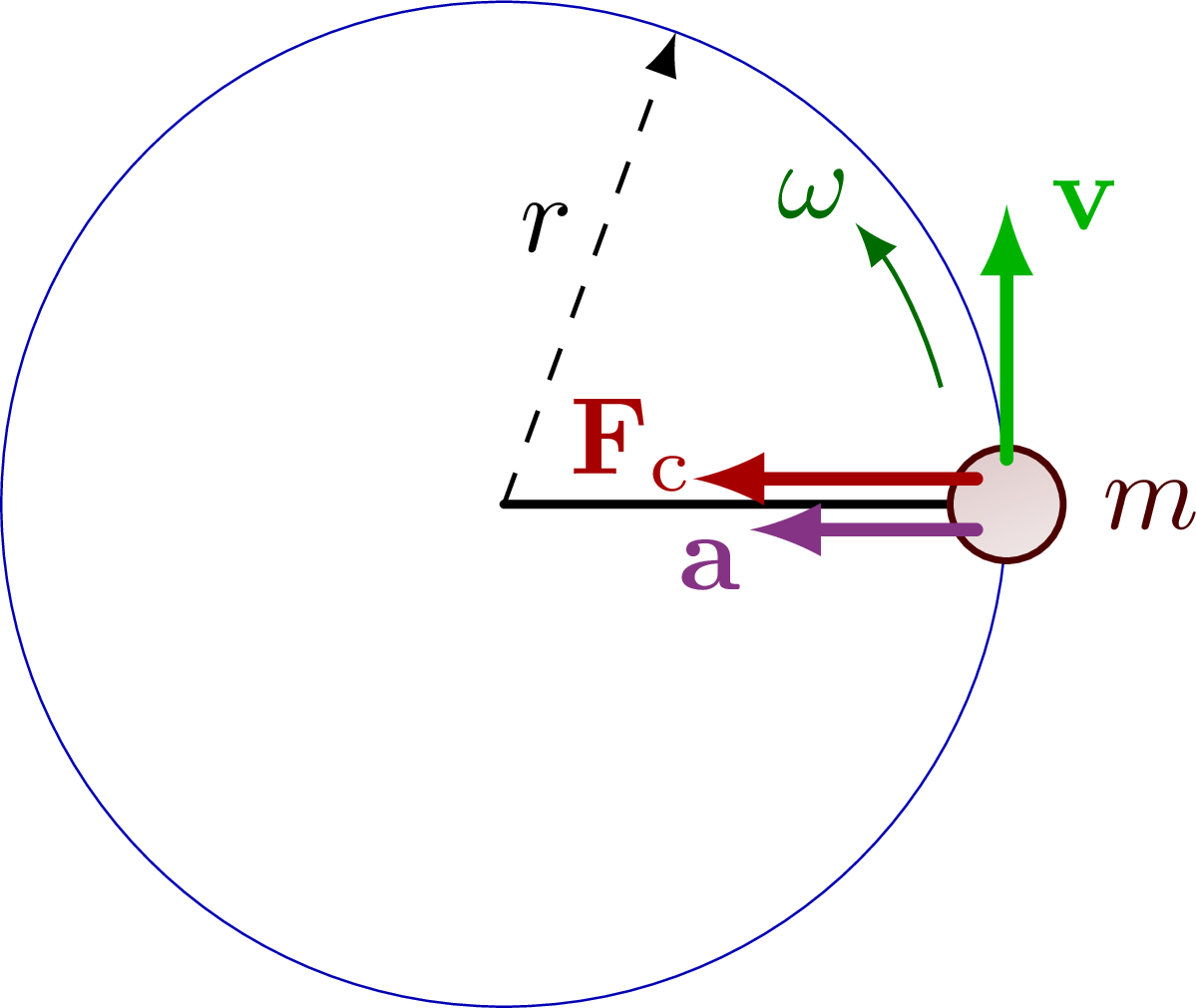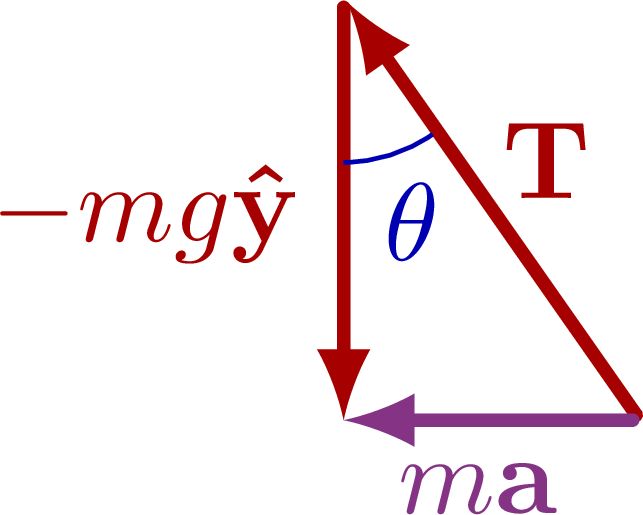The basics of the centripetal force in uniform circular motion, including a mass suspended from a string.
More on uniform circular motion here. For more related figures, please see the “forces” and “Newton’s laws” tag.
Edit and compile if you like:
% Author: Izaak Neutelings (October 2020)
% Inspiration: https://tex.stackexchange.com/questions/25531/adding-underbrace-in-tikz
\documentclass[border=3pt,tikz]{standalone}
\usepackage{physics}
\usepackage{siunitx}
\usepackage{ifthen}
\usepackage{tikz}
%\usepackage[outline]{contour} % glow around text
\usetikzlibrary{calc}
\usetikzlibrary{angles,quotes} % for pic
\usetikzlibrary{patterns}
\tikzset{>=latex} % for LaTeX arrow head
%\contourlength{1.4pt}
\colorlet{xcol}{blue!70!black}
\colorlet{vcol}{green!70!black}
\colorlet{myred}{red!65!black}
\colorlet{acol}{red!50!blue!80!black!80}
\tikzstyle{ground}=[preaction={fill,top color=black!10,bottom color=black!5,shading angle=20},
fill,pattern=north east lines,draw=none,minimum width=0.3,minimum height=0.6]
\tikzstyle{metal}=[fill,top color=black!40,bottom color=black!20,shading angle=10]
\tikzstyle{mass}=[line width=0.6,red!30!black,fill=red!40!black!10,rounded corners=1,
top color=red!40!black!20,bottom color=red!40!black!10,shading angle=20]
\tikzstyle{rope}=[brown!70!black,very thick,line cap=round]
\def\rope#1{ \draw[black,line width=1.5] #1; \draw[rope] #1; }
% FORCES SWITCH
\tikzstyle{force}=[->,myred,very thick,line cap=round]
\tikzstyle{Fproj}=[force,myred!40]
\newcommand{\vbF}{\vb{F}}
\newcommand{\vbT}{\vb{T}}
\begin{document}
% CIRCULAR MOTION - 2D
\begin{tikzpicture}
\def\R{1.6} % string length
\def\r{0.18} % ball radius
\def\Ry{0.5} % small radius of the ellipse
\def\F{0.9} % force size
\coordinate (O) at (0,0);
\coordinate (M) at (\R,0);
\coordinate (F0) at ($(M)+(104:0.8*\r)$);
\coordinate (F) at ($(F0)+(90:\F)$);
\draw[very thin,xcol] (O) circle (\R);
\draw[->,dashed] (O) -- (70:\R) node[midway,above left=-2] {$r$};
\draw[thick,line cap=round] (O) -- (\R,0); %node[midway,above left=-2] {$r$};
\draw[thin,mass] (M) circle (\r) node[right=5] {$m$};
\draw[force] (M)++(140:0.7*\r) --++ (-\F,0) node[below=1,above left=-4] {$\vb{F}_\mathrm{c}$};
\draw[force,acol] (M)++(-140:0.7*\r) --++ (-0.8*\F,0) node[below left=-3] {$\vb{a}$};
\draw[force,vcol] (M)++(90:0.8*\r) --++ (0,0.9*\F) node[right=0] {$\vb{v}$};
\draw[->,vcol!50!black] (15:0.9*\R) arc(15:40:0.85*\R) node[above left=-3] {$\omega$};
\end{tikzpicture}
% CIRCULAR MOTION string
\begin{tikzpicture}
\def\L{2.8} % string length
\def\r{0.18} % ball radius
\def\Ry{0.5} % small radius of the ellipse
\def\ang{35} % angle
\def\F{1.2} % force size
%\def\dang{17} % angle offset
\coordinate (O) at (0,0);
\coordinate (T) at (0,{\L*cos(\ang)});
\coordinate (M) at ({\L*sin(\ang)},0);
\coordinate (F0) at ($(M)+(104:0.8*\r)$);
\coordinate (F) at ($(F0)+(90+\ang:\F)$);
%\coordinate (Fy) at ($(F0)+(90:{\F*cos(\ang)})$);
%\coordinate (Fx) at ($(F0)+(180:{\F*sin(\ang)})$);
% STRING + MASS
\draw[very thin,xcol] (M) arc (0:180:{\L*sin(\ang)} and \Ry);
\draw[dashed] (T) -- (O) node[midway,left=-1] {$h$} -- (0,-0.1*\L);
\draw[dashed] (M) -- (O) node[midway,below=-1] {$r$} -- (-0.1*\L,0);
\draw[thin,mass] (M) circle (\r) node[right=5] {$m$};
\draw[thick,line cap=round] (T) --++ (\ang-90:\L-0.9*\r) node[midway,left=1,below=1] {$L$};
%\draw[thin,xcol] (O) ellipse ({\L*sin(\ang)} and \Ry);
%\draw[very thin,xcol] (\dang:{\L*sin(\ang)} and \Ry) arc (\dang:358:{\L*sin(\ang)} and \Ry);
\draw pic["$\theta$",xcol,draw=xcol,angle radius=14,angle eccentricity=1.45] {angle=O--T--M};
% FORCES
\draw[<->] (M)++(75:8*\r) node[left=-2,scale=0.9] {$x$} -|++ (3*\r,3*\r) node[below=4,right=0,scale=0.9] {$y$};
%\draw[dashed,myred!80!black!60] (Fx) -- (F) -- (Fy);
%\draw[force] (F0) -- (F) node[above=3,right=-1] {\contour{white}{$\vbT$}};
\draw[force] (F0) -- (F) node[below=2,right=4] {$\vbT$};
%\draw[Fproj] (F0) -- (Fy) node[below=2,right=0] {$\vbT_y$};
%\draw[Fproj] (F0) -- (Fx) node[above=2,left=-3] {$\vbT_x$};
\draw[force] (M)++(0,-0.2*\r) --++ (-90:{\F*cos(\ang)}) node[midway,right=0] {$-mg\vu{y}$};
%\draw[force,acol] (M) --++ (180:{\F*sin(\ang)}) node[midway,below=0] {$m\vb{a}$};
\draw[force,acol] (M)++(160:0.9*\r) --++ (180:{\F*sin(\ang)}) node[above=4,left=-3] {$m\vb{a}$};
%\draw pic["$\theta$",xcol,draw=xcol,angle radius=14,angle eccentricity=1.45] {angle=Fy--F0--F};
%\draw pic["$\theta_3$",xcol,draw=xcol,angle radius=13,angle eccentricity=1.40] {angle=F3--O--T};
\draw[very thin,xcol] (170:{\L*sin(\ang)} and \Ry) arc (170:357:{\L*sin(\ang)} and \Ry);
\end{tikzpicture}
% CIRCULAR MOTION - force balance
\begin{tikzpicture}
\def\ang{35} % angle
\def\F{1.6} % force size
\def\r{0.18} % ball radius
\coordinate (O) at (0,0);
\coordinate (F) at (90+\ang:\F);
\coordinate (Fy) at (90:{\F*cos(\ang)});
\coordinate (Fx) at (180:{\F*sin(\ang)});
\draw[thin,mass] (O) circle (\r) node[right=5] {$m$};
\draw[dashed,myred!80!black!60] (Fx) -- (F) -- (Fy);
\draw[Fproj] (O) -- (Fy) node[below=2,right=0] {$\vbT_y$};
\draw[Fproj] (O) -- (Fx) node[above=2,left=-2] {$\vbT_x$};
\draw[force] (O) -- (F) node[above left=-3] {$\vbT$};
\draw[force] (O) --++ (-90:{\F*cos(\ang)}) node[midway,right=0] {$-mg\vu{y}$};
\draw[force,acol] (O)++(-130:1.6*\r) --++ (Fx) node[midway,right=2,below=0] {$m\vb{a}$};
\draw pic["$\theta$",xcol,draw=xcol,angle radius=14,angle eccentricity=1.45] {angle=Fy--O--F};
\end{tikzpicture}
% CIRCULAR MOTION - force balance - tip to toe (or but?)
\begin{tikzpicture}
\def\ang{35} % angle
\def\F{1.6} % force size
\def\r{0.18} % ball radius
\coordinate (O) at (0,0);
\coordinate (F) at ((90+\ang:\F);
\coordinate (Fx) at (180:{\F*sin(\ang)});
\draw[force] (90-\ang:0.02) --++ (F) node[midway,above right=-3] {$\vbT$};
\draw[force] (F) -- (Fx) node[midway,left=0] {$-mg\vu{y}$};
\draw[force,acol] (O) -- (Fx) node[midway,left=1,below=0] {$m\vb{a}$};
\draw pic["$\theta$",xcol,draw=xcol,angle radius=14,angle eccentricity=1.45] {angle=Fx--F--O};
\end{tikzpicture}
\end{document}Click to download: dynamics_circle.tex • dynamics_circle.pdf
Open in Overleaf: dynamics_circle.tex





